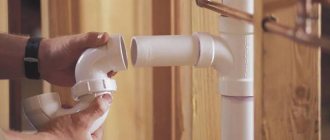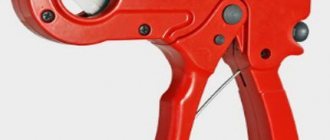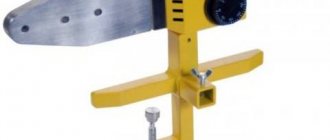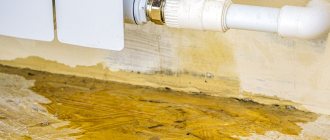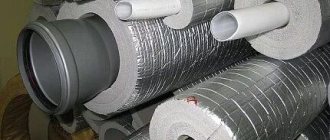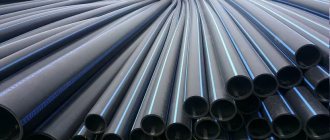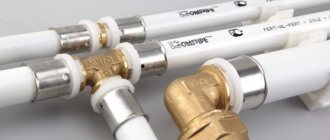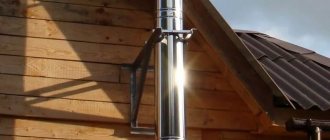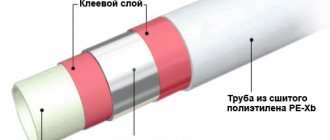The main features of plastic pipes include lower price and weight, increased service life, and ease of installation. Particularly noteworthy is the ability to connect pipes without soldering or with it, but in a faster way than metal analogues.
Let's figure out what options there are for connecting polypropylene pipes and how to apply various assembly technologies at home.
One way to connect a pipeline Source atyourserviceplumbingcompany.com
Polypropylene pipes: connection methods
The choice of technology for assembling a plastic pipeline depends on the type of products and their properties. The methods used for joining sections are divided into two large groups:
- The first one is “hot”.
This involves welding or soldering, that is, heating the material to change its state of aggregation. This method is used to form a deposit at the joint, and ensures the absence of leaks and uniform distribution of mechanical loads.
A welded joint is, first of all, a one-piece type of installation. This type of pipe connection is permanent and is used until the expiration date of the products. This method is more often used to achieve high pipeline strength. Soldering is done using special equipment or improvised tools.
Method of connecting polypropylene pipes by soldering Source vodatyt.ru
- The second is “cold”.
Involves connecting polypropylene pipes without soldering. This method is used when quick joining is necessary, in the absence of welding skills.
The installation method in this option is detachable or threaded. It can be used when connecting thin pipes, polypropylene and metal. When using this “cold” method, connecting elements are used - polypropylene fittings, the sizes and dimensions of which are selected to match the main product - pipes.
Knowing how to connect polypropylene pipes without soldering, you can pre-select elements suitable for operating conditions and ensure quick assembly.
Installation of polypropylene pipes using improvised means Source moikolodets.ru
Diagrams by type of coolant supply
The radiator will work effectively if the coolant is evenly distributed across all sections.
Warm and cold water have different densities. The heated coolant always tends upward. In the system it is replaced by cold, denser water. This feature is taken into account when supplying coolant to the batteries.
Coolant supply diagram
Upper eyeliner
Each radiator has vertical channels connecting the horizontal upper and lower manifold. The presence of these elements allows the coolant to circulate in the device.
With the top connection, mainly only the top of the battery heats up. To prevent such an effect, a jumper is installed after the first rib in the direction of flow of the coolant. Therefore, the heated water first falls into the lower collector.
Then it passes through all sections of the radiator and enters the return pipeline. As a result, the top connection turns into a diagonal way to connect the battery.
If there is no jumper in the radiator, the supply pipe is connected at the top, and the return pipe at the bottom from the opposite end of the battery. This option is called diagonal strapping.
Bottom eyeliner
This is the easiest way to tie. The scheme involves installing the boiler in the basement or on the ground floor. From the heat generating unit, the main pipeline is led to the attic, where the expansion tank is installed. A starting line is laid from the tank, but not lower than 1.5 m to the first radiator.
The supply and return are connected to the batteries at the lowest points on opposite sides. All radiators in the system are connected to pipelines in the same way and installed in series.
When installing a heating circuit with natural circulation, the pipes are laid at an angle. The last battery must be located above the boiler. The height difference between the final radiator and the heat generating unit should not exceed 3 m.
Connection in progress:
- circulation pump;
- bypasses;
- shut-off valves;
- Mayevsky cranes.
Pumping equipment runs on electricity. When it is turned off, circulation of the coolant is possible only in a natural way. Therefore, it is better to lay pipelines at a slope.
“Hot” joining method: welding options
When using this method, 2 welding options are used:
- Soldering pipe to pipe is the most popular method.
- Fusion welding of couplings (adapters).
The first method is used when welding pipes with a diameter of more than 40 mm. The second is on pipes with a diameter from 16 to 40 mm. In this case, the fitting is needed not only to adjust the direction of pipe laying, but also as a supply of material for melting.
Various configurations of couplings (adapters) Source education-web.ru
Coupling configurations are selected based on the characteristics of the pipeline. The following types of adapters are available:
- Corners . Change of direction in any direction.
- Tees . Distribution of water supply and change of direction.
- Couplings . Docking without changing direction.
The following elements also apply:
- Bypass fittings.
- Ball valves.
- Combined products including metal-plastic.
- Threaded inside or outside pipes.
Homemade wall chaser
A professional wall chaser is an expensive tool, and in terms of its operating principle and design it is practically no different from an angle grinder. This allows craftsmen to make some changes to the design of the angle grinder elements to effectively perform the gating functions.
Two disks. Installing two discs allows you to speed up work and improve its quality - the channel is cut in one pass, and its width is the same along its entire length. If the groove is narrow, the alteration is quite simple - a second disk is placed on the grinder, the width of the groove is set by a washer installed between the disks. To increase the distance between the cutting wheels, you can make an attachment for an angle grinder on a lathe with a wider seat.
Fig.9 How to make furrows for water supply pipelines with a grinder without dust
Nozzle for vacuum cleaner. To combat dust, some craftsmen make a separate attachment for an angle grinder with a fitting for connecting a vacuum cleaner. To implement this improvement, soldering or welding work that is quite difficult for a non-specialist is required.
There is an easier way to deal with dust - tie a piece of water pipe to the handle of an angle grinder with masking tape and connect a vacuum cleaner to it.
Mechanical joining method without soldering: connection options
Soldering as a method of joining pipeline sections is more often used during installation supervision in production. In everyday life, the most popular technologies are express installation without welding.
The time-tested practice of joining without the use of special tools ensures high quality joints of plastic pipes without soldering using couplings.
The widely known method is based on the use of shaped parts. With their help, you can not only ensure the continuation of the water supply circuit, but also change its direction, distribute the working medium or block the flow.
Advantages of installation technology without heating:
- Finished polypropylene products are cheaper to connect using this method than metal ones due to the low cost of fittings.
Connections of plastic pipes without soldering using couplings Source stroy-podskazka.ru
- The design of the fittings makes it possible to manually assemble a complete engineering system of drainage, water supply, and sewerage.
The size and technical capabilities of parts are determined by their configuration (shape, wall thickness, combination).
Connection using compression fittings
When choosing how to connect plastic pipes for water supply without soldering, many people often use the compression fitting method. With this connection method, the process of heating adjacent parts is eliminated. A special coupling, under mechanical action (crimping), reliably fixes the two ends of the tubes equipped with o-rings inside. After installing the adapter, the joints are lubricated with silicone sealant.
Switching from metal-plastic to polypropylene using fittings is an indispensable way to join pipes made of different materials.
The advantages of this method:
- a minimum set of tools is used for installation;
- Even a beginner can trust the pipeline connection;
An example of lubricant used when installing polypropylene pipes Source construct.smazka.ru
- a reliable connection is created at the installation site of the compression fitting;
This method, first of all, is good because it can be used when updating cast-iron water pipes with polypropylene analogues. This method is also in demand when assembling heating systems, including the installation of radiators.
Connection using adhesives
Among the docking options that make it possible to do without special equipment is the use of assembly adhesives.
The base composition of the adhesive is polyvinyl chloride mixed with a solvent. Manufacturers also add various additives and plasticizers to it to improve adhesion at joints.
Advantages of the method:
- joining products using an adhesive provides the assembled structure with the necessary characteristics of strength and tightness;
- upon completion of work, a reliable connection is formed at the installation site, invisible during visual inspection;
- No special skills are required for docking.
Important ! During work, safety precautions should be observed, do not work near open sources of fire and avoid contact of the composition with the skin.
Fitting polypropylene pipes before gluing Source www.asvshop.com
See also: Catalog of companies that specialize in engineering communications.
How to install with glue
Before connecting polypropylene pipes, you need to prepare the necessary parts, tools and provide conditions for installation work.
The surfaces on which the adhesive composition will be applied should be treated with a degreaser. To apply the composition, a brush with bristles made from natural materials is suitable. It is also recommended to ensure the room temperature ranges from 5 to 35 degrees.
Considering that the pipeline parts will be joined with a minimum gap, a thin layer of glue will be sufficient. Holding the pipes until they set usually does not exceed 20-30 seconds. Upon completion of work, it is recommended to ventilate the room well, while drafts should be avoided.
How metal-plastic and polypropylene pipes are joined
There is only one way to install pipes made of different materials. This is a threaded installation, since soldering and gluing products cannot be used here.
This is explained by the fact that the joint must not only be hermetically sealed, but also be able to experience high dynamic loads (maximum pressure difference).
Quick installation of pipes from various materials Source glawtruba.ru
Before connecting a metal-plastic pipe with a polypropylene pipe, you need to select the necessary parts:
- Metal-plastic products are equipped with special tips.
- Polypropylene sections, in turn, are equipped with a coupling on which a thread is applied.
Bell-shaped technology for assembling plastic pipelines
Fixation using this method is justified only when operating in low pressure systems. The insert into the socket ensures quick and easy installation, suitable for sewer and drainage engineering systems.
The ends of the pipes at the installation site must have a precisely adjusted diameter.
The section with the socket is, accordingly, inserted into the end of the pipe with a seal. The work will not require special knowledge or the purchase of special fittings.
The procedure for assembling pipelines by driving them into a socket
To eliminate possible diametrical errors in the joined sections, there is a rubber ring in the socket tip. The task of this element is to ensure tightness under mechanical stress on the pipeline.
Assembly of various polypropylene pipes Source www.uponor-usa.com
To facilitate the driving process itself, lubricant is used. The composition is applied to the smooth part of the end cut. The docking process is controlled using markings. This will prevent the user from driving the pipe too deep and damaging the section.
Normalized immersion of the bell allows not only to ensure material savings, but also to maintain a standard gap, which is necessary to compensate for loads during linear expansion - phenomena that occur with temperature differences.
Grinding concrete walls in panel houses with a grinder
Using a grinder, you get a groove with neat, even edges - this makes further placement of the pipeline in the channel easier, and its use significantly increases the speed of work. The scoring procedure using a grinder consists of the following steps:
- Place a diamond-coated concrete disc on the grinder and cut the wall strictly along the line to the required depth, not forgetting to use dust protection during work.
- Using a hammer drill with a spade attachment or a chisel and hammer, knock out the concrete between the cut grooves. When carrying out work, control the deepening of the groove with a piece of pipe, trying to maintain a depth of at least 5 mm. from the plane of the wall.
- After the work is completed, the channel is cleaned of dirt and dust accumulated in it using a brush; before sealing with gypsum binder, the surface of the groove is moistened.
Rice. 7 How to make grooves for pipes when using a hammer drill
Classification of fittings and adapters
Assembling pipelines using special nozzles is the most popular method of wiring engineering systems. In order to select the necessary types of fittings for polypropylene pipes, you should familiarize yourself with their detailed classification.
For the manufacture, release and supply of technical polypropylene products, the provisions of state standard No. 52134 of 2003 are used.
Types of fittings for polypropylene pipes Source ecomont.ru
Installation parameters of pipes and fittings
In the selection of polypropylene pipes and adapters to match the technical design of the building, simple physical principles are used.
The dimensions of fittings for polypropylene pipes in mm can be selected depending on the diameter of the polypropylene pipes, their thickness, and resistance to temperature influences.
For a home where there is free space and the mechanical strength of pipelines is important, elements with a thickness of 16 mm or more are laid. This takes into account the difference between the internal and external diameters of the products. The thickness of the pipes and fittings will compensate for the missing characteristics.
The first among the installation parameters is the operating pressure, indicated by the PN marking.
| PN10 or 10 bar | PN16 or 15 bar | PN20 or 20 bar | PN25 or 25 bar | |
| Pipe outer diameter | 16-110 mm | |||
| Wall thickness | From 1.9 to 10 mm | From 2.7 to 18.4 mm | From 3.4 to 6.9 mm | |
| Maximum temperature | 45°C | 60°C | 75°C | 95°C |
| Scope of application | Cold water supply, low pressure pipelines | |||
| Reinforcement | No | No | Eat | Eat |
In this case, you should not focus only on the wall thickness parameters. If there is reinforcement (fiberglass), the outer diameter of the pipes increases.
Selecting fittings for polypropylene pipes by size is not so difficult, you just need to find tables of recommended adapters and their diameters.
Before installing pipes at home without a soldering iron, you need to select the sizes of fittings and couplings in mm or inches Source image.isu.pub
Hydraulic calculation of a single-pipe system
Hydraulic calculations are carried out to determine the diameter of the connecting pipes in each section of the circuit and the performance of the circulation pump.
Sequence of calculations:
- Determination of heat loss through building structures.
- Calculation of the required heat transfer from radiators for each room.
- Selecting a boiler of the required power.
- Calculation of the diameter of the supply pipes, taking into account the circulation rate of the coolant in the coldest time of the year.
- Selecting a circulation pump if you need a remote option.
Determination of heat loss and calculation of radiators
The heat generated by the boiler is dissipated through the floor, walls and ceiling of the building. They take into account the material of the walls, the number and area of windows and doors, and the quality of insulation.
You can use the calculator on our website:
For small houses, an approximate option is used. It is believed that in the northern regions, to heat 10 m2 of area, 1.5-2 kW of boiler power and radiator heat transfer performance are required. In the middle zone the figure is 1-1.5 kW, in the southern regions - 0.6-1 kW. The data is correct for houses with solid walls and medium or high-quality thermal insulation.
Knowing the dimensions of the house, they obtain the necessary data for subsequent calculations. It is important to determine the required number of radiators for each room. Aluminum and bimetallic radiators in most cases emit from 120 to 210 W per section. By dividing the power required for the room by the performance of the section, the battery dimensions are obtained.
Boiler selection
The heating boiler will work much longer if it does not heat the coolant at maximum mode. In this regard, equipment is chosen that is 10-20% more powerful than the heat loss obtained in the calculations. For example, with a loss of 10 kW, a boiler designed for 12-14 kW is purchased.
Determination of pipe cross-section
The optimal speed of coolant movement through the pipes is from 0.3 to 0.7 m/s. If the parameter is lower, then at low temperatures the radiators may not warm up sufficiently. At higher speeds, the radiators often become airy and noise is heard. Based on the flow rate, pipes with the required internal cross-section are selected.
The required coolant flow is determined by the formula: G=860* q/ΔT , in which:
- G—flow rate kg/h;
- q is the thermal power in the circuit section (kW);
- ΔT is the difference in temperature of the coolant at the inlet and outlet of the radiator, usually taken to be 20 °C.
For example, to ensure heat transfer from a circuit of 2 kW, we obtain the coolant flow rate: 860*2/20=85 kg/h.
Next, special tables compare the flow rate and the generated thermal performance. In our example, for 2 kW radiators, a pipe with an internal cross-section of 8 to 12 mm is sufficient. Highlighted in the table with a red frame.
Table for determining the diameter of pipes of a gravity heating system
Data for each circuit is plotted on a general diagram. By summing up the data obtained, they determine which pipe diameter to choose for connecting to a group of circuits or for each riser.
Pump selection
Modern gas and electric boilers are equipped with a built-in pump. Its performance is selected by the manufacturer based on the boiler power.
The required performance of the remote pump is determined by summing the coolant flows in each circuit. They provide a reserve of 15-20% in performance so that the pump operates in a gentle mode.
Fastening methods used in everyday life
Each apartment owner independently determines the level of installation quality he requires. Some people use soldering, while others use adapters or other alternatives.
"Hot" soldering of pipes
Considering soldering as the most reliable and durable method of fastening, some private property owners use this method of pipeline installation. In the absence of special equipment, they use a gas burner. In this case, you can save on purchasing a soldering iron and work with pipes of any diameter.
Workflow Features:
- The gas burner must be selected according to the type of fuel used. The gas with the highest combustion temperature is suitable for thicker pipes.
- It is best to select pipe sections of the same diameter. This will ensure an aesthetic appearance of the engineering system, preservation of operating parameters in all sections of the pipeline and the absence of difficulties during soldering.
- Before starting installation, it is recommended to mark (cut) the entire contour, clean the ends of the joints, and degrease them with a special compound.
Installation of polypropylene pipes using a gas burner Source ytimg.com
Leningradka
One of the popular and easy-to-implement schemes began to be widely used in Leningrad, hence the name. Its peculiarity is the way the radiators are connected - in series with bypasses for each battery.
Leningradka open type.
Leningradka closed type.
The scheme is suitable for open and closed systems, with natural and forced coolant circulation. The design can be implemented in vertical and horizontal layout.
Thus, Leningradka is a universal scheme for constructing single-pipe heating systems. It has all the described advantages, but its disadvantages limit its use in large houses.
Possible Solution! In branched networks, several heating branches are made with 3-5 radiators in each. For example, they separate the heating circuits of the first and second floors. For houses with a large area, it is more advisable to use two-pipe systems.
Briefly about the main thing
Lightweight, durable plastic pipes are easily connected to any materials in a variety of ways. There are detachable and non-detachable installation methods:
- The first option includes the use of compression fittings, threaded elements, and couplings.
- The second option uses “cold” and “hot” welding and gluing. The connection occurs using special compounds, for example, solder tapes and pastes, glue, epoxy resin, or simply by heating the plastic to the melting point.
When choosing how to connect metal-plastic with polypropylene at home, pay attention to the technology of compression fittings or threads with plastic elements.
Today, this is the only way to connect dissimilar sections, for example, cast iron and plastic. With compression fittings, the pipe connection can be quickly updated if necessary by replacing parts. The same cannot be said about the soldering method.
When there is no special tool at hand, electrical fittings can be used. Once connected, these elements quickly solder individual sections of the pipeline.
Before installation using the detachable method, you need to select fittings for the pipeline based on operational characteristics (temperature, pressure, dimensions). Fittings marked PPG are suitable for heating systems.
Our advice
Before you begin the process of soldering pipes, it is better to perform a couple of practice joints. It is easier to work with small joints by installing the welding machine directly on the table. This way you can check how correctly the pipe soldering is performed.
But attaching elements to a partially finished pipeline will be more difficult:
- Place a soldering iron nozzle on the polypropylene pipe, insert a tee into the other part, holding the welding machine suspended.
- When preparing the main water supply, it is necessary to alternate subsequent connections. In hard-to-reach areas, it is better to avoid joining work due to the difficulty of using a soldering iron.
- The material must be dry and clean, because the presence of dirt and water will reduce the quality of the joint. It is known that the material, if wet, can deform when heated.
- Purchase all products (pipes, fittings) from the same manufacturer, because the chemical composition of elements from different manufacturers may differ, which will ultimately lead to a leaky connection.
- The temperature in the room where work with polypropylene is carried out must be optimal and not lower than +5̊C.
